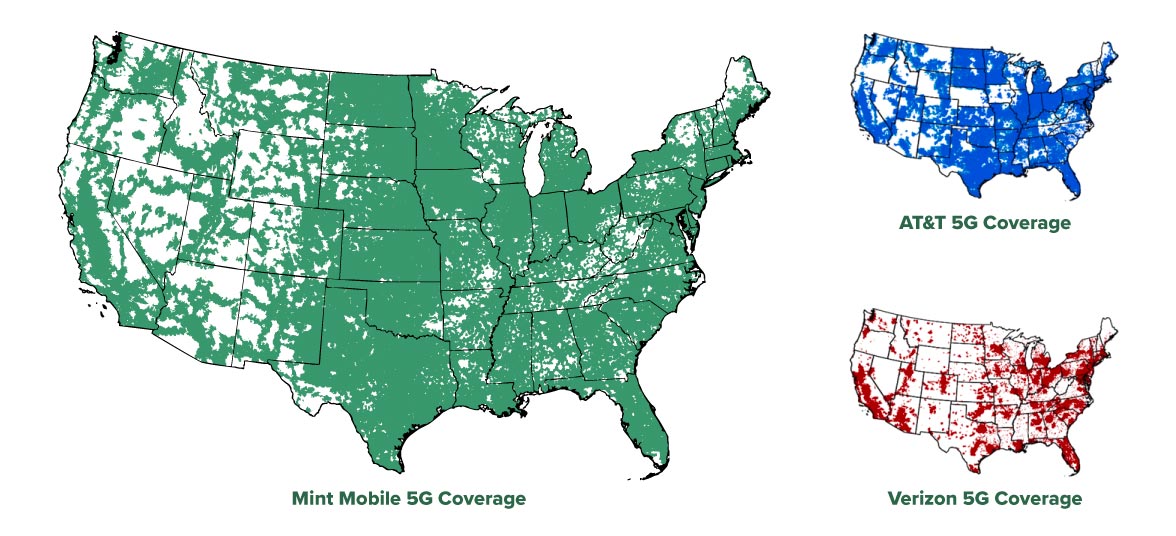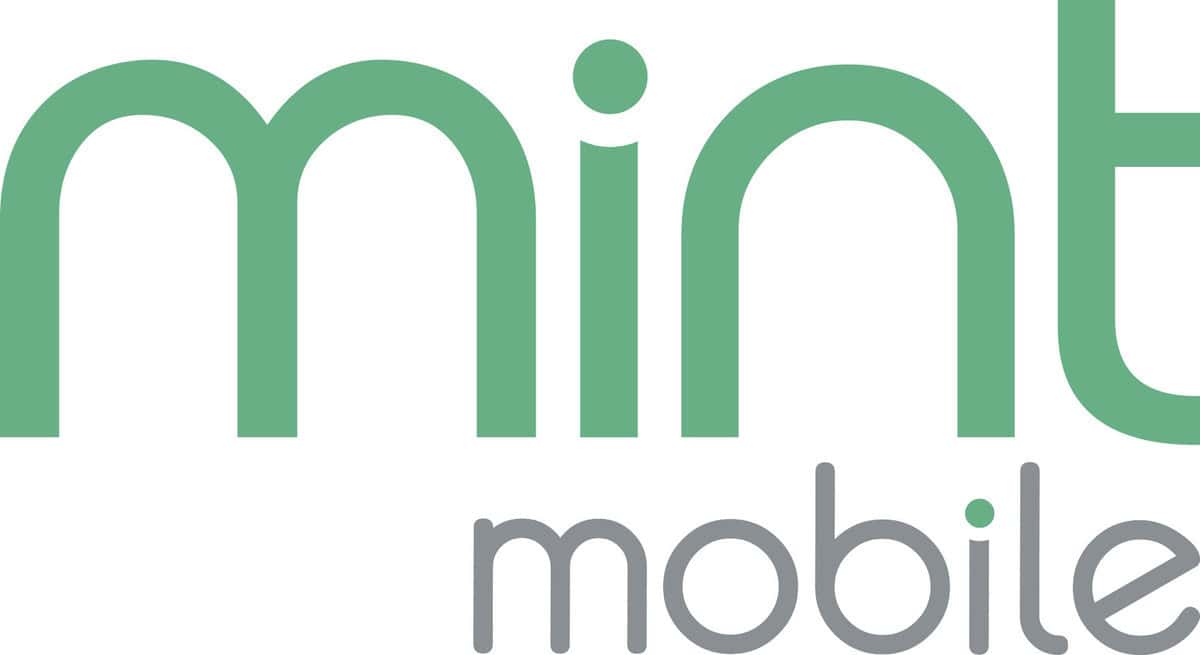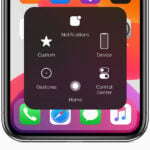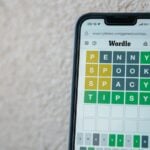Mint Mobile has been gaining attention as an affordable mobile phone service with comprehensive coverage. Operated as an MVNO (Mobile Virtual Network Operator), Mint Mobile uses the T-Mobile network to provide service to its customers. This partnership allows Mint Mobile to offer extensive 4G LTE and 5G coverage, essential for today’s mobile users who rely heavily on fast data speeds for streaming, browsing, and downloading.
Knowing the scope of the coverage is vital for potential and current users alike. Mint Mobile proudly touts a significant 5G coverage footprint, covering a large portion of the contiguous United States. Users considering Mint Mobile can check the coverage map on the company’s website to confirm service availability in their area. It’s important for consumers to verify compatibility with their devices to fully benefit from the services Mint Mobile offers.

Understanding Mint Mobile’s Network Infrastructure
T-Mobile Network Partnership
Mint Mobile operates as a Mobile Virtual Network Operator (MVNO) that utilizes T-Mobile’s nationwide network infrastructure:
| Network Aspect | Mint Mobile Access | Coverage Benefit |
|---|---|---|
| 4G LTE Coverage | Full T-Mobile network | 99% of Americans covered |
| 5G Coverage | T-Mobile’s 5G network | 98% of Americans covered |
| Network Priority | Lower than T-Mobile postpaid | Potential slower speeds during congestion |
| Roaming Access | Limited compared to T-Mobile | Primarily T-Mobile native coverage |
| Network Updates | Same infrastructure improvements | Benefits from T-Mobile’s ongoing expansion |
Mint Mobile provides access to the nation’s largest 5G network through its T-Mobile partnership, delivering reliable coverage to 98% of Americans with 5G and 99% with 4G LTE (source: Mint Mobile Coverage).
Coverage Technology Breakdown
5G Network Coverage
- 5G Extended Range: Wide area coverage with improved penetration
- 5G Ultra Capacity: High-speed coverage in dense urban areas
- 5G Nationwide: Basic 5G coverage across most service areas
4G LTE Network Specifications
- Band 2 (1900 MHz): Urban and suburban coverage
- Band 4 (1700/2100 MHz): High-capacity urban coverage
- Band 12 (700 MHz): Extended range and building penetration
- Band 71 (600 MHz): Long-range rural and indoor coverage
Geographic Coverage Analysis
National Coverage Overview
| Coverage Type | Population Coverage | Geographic Coverage | Real-World Impact |
|---|---|---|---|
| 4G LTE | 99% of Americans | ~70% of US landmass | Excellent urban/suburban, good rural |
| 5G | 98% of Americans | ~65% of US landmass | Strong metropolitan, expanding rural |
| Voice/Text | 99%+ of Americans | ~75% of US landmass | Reliable basic connectivity |
Regional Performance Breakdown
Excellent Coverage Regions
- Northeast Corridor: Boston to Washington DC
- California Coast: San Francisco to San Diego
- Florida: Miami to Jacksonville corridor
- Texas Triangle: Houston, Dallas, San Antonio, Austin
- Great Lakes Region: Chicago, Detroit, Cleveland metro areas
Good Coverage Regions
- Pacific Northwest: Seattle, Portland metropolitan areas
- Mountain West Urban: Denver, Phoenix, Salt Lake City
- Southeast: Atlanta, Charlotte, Nashville metro regions
- Midwest Cities: Kansas City, St. Louis, Minneapolis
Limited Coverage Areas
- Rural Montana: Eastern plains and mountain regions
- Wyoming: Outside major highway corridors
- Northern Maine: Remote areas beyond Interstate 95
- Nevada Desert: Areas between major cities
- Alaska: Limited coverage compared to major carriers
Coverage Comparison with Major Carriers
Mint Mobile vs. Verizon Coverage
| Coverage Aspect | Mint Mobile | Verizon | Advantage |
|---|---|---|---|
| Rural Coverage | Good (T-Mobile network) | Excellent | Verizon leads in remote areas |
| Urban Coverage | Excellent | Excellent | Comparable performance |
| 5G Deployment | Extensive (T-Mobile) | Wide but different tech | T-Mobile/Mint stronger in many metros |
| Building Penetration | Good with Band 71 | Excellent | Verizon slight edge indoors |
| Highway Coverage | Very good | Excellent | Verizon marginally better on interstates |
Mint Mobile provides access to the nation’s largest 5G network at an incredibly low price, while Verizon offers the most geographically widespread 4G LTE coverage, especially in rural America, but at a premium cost (source: Pixels SEO).
Mint Mobile vs. AT&T Coverage
| Network Metric | Mint Mobile | AT&T | Performance Notes |
|---|---|---|---|
| Total Coverage Area | T-Mobile network footprint | Slightly larger geographic area | AT&T marginal advantage in rural areas |
| 5G Speed | T-Mobile’s faster 5G | Solid but generally slower | Mint/T-Mobile advantage in 5G performance |
| Network Congestion | MVNO deprioritization | Native network priority | AT&T advantage during peak usage |
| International Roaming | Limited options | Extensive global coverage | AT&T significantly better for international travel |
State-by-State Coverage Analysis
Top Performing States
| State | Coverage Quality | Population Covered | Notable Strengths |
|---|---|---|---|
| California | Excellent | 99%+ | Strong urban and suburban coverage |
| Texas | Excellent | 98%+ | Good rural coverage between major cities |
| Florida | Excellent | 99%+ | Consistent statewide performance |
| New York | Excellent | 99%+ | Superior urban density handling |
| Illinois | Excellent | 98%+ | Strong Chicago metro, good rural Illinois |
Challenging Coverage States
| State | Coverage Challenges | Affected Areas | Workaround Solutions |
|---|---|---|---|
| Montana | Rural gaps | Eastern plains | Wi-Fi calling, travel planning |
| Wyoming | Sparse rural coverage | Between major highways | Download offline maps, emergency planning |
| West Virginia | Mountain terrain issues | Mountainous regions | Indoor signal boosters |
| Maine | Northern rural gaps | Above Bangor region | Roaming preparation for travel |
| Nevada | Desert coverage gaps | Between cities | Route planning for road trips |
Urban vs. Rural Performance
Metropolitan Areas (Population > 1 Million)
| Metro Category | Mint Mobile Performance | Speed Expectations |
|---|---|---|
| Major Cities | Excellent (comparable to T-Mobile) | 50-200+ Mbps 5G |
| Secondary Cities | Very Good | 25-100 Mbps typical |
| Suburban Areas | Good to Excellent | 20-75 Mbps average |
| Edge of Metro | Good | 10-40 Mbps typical |
Rural Performance Characteristics
| Rural Area Type | Coverage Expectation | Speed Range | Reliability Notes |
|---|---|---|---|
| Interstate Highways | Good to Excellent | 5-50 Mbps | Generally reliable for travel |
| State Highways | Fair to Good | 1-25 Mbps | Some gaps possible |
| Small Towns | Good | 5-30 Mbps | Usually well covered |
| Remote Areas | Limited to None | Variable | May require alternative solutions |
Real-World Coverage Performance
Speed and Performance Expectations
Typical Speed Ranges by Area Type
| Location Type | 4G LTE Speeds | 5G Speeds | Upload Speeds |
|---|---|---|---|
| Dense Urban | 15-60 Mbps | 50-300+ Mbps | 5-50 Mbps |
| Suburban | 10-50 Mbps | 25-150 Mbps | 3-25 Mbps |
| Rural/Small Town | 5-30 Mbps | 10-100 Mbps | 1-15 Mbps |
| Highway Travel | 5-40 Mbps | 15-100 Mbps | 1-20 Mbps |
Network Performance Factors
Peak Hour Performance
- Business Hours (9 AM – 5 PM): Potential slowdowns in business districts
- Evening Rush (5 PM – 8 PM): Possible congestion in residential areas
- Weekend Peak (2 PM – 6 PM): Shopping centers and entertainment venues may see reduced speeds
- Late Night/Early Morning: Typically fastest speeds due to low network usage
Deprioritization Impact As an MVNO, Mint Mobile customers may experience slower data speeds during network congestion compared to T-Mobile’s direct customers, particularly in crowded areas during peak usage times.
Coverage Testing and Verification
Using Mint Mobile’s Coverage Map
Official Coverage Map Features
- Interactive Mapping: Zoom into specific areas for detailed coverage
- Address Verification: Enter specific addresses for coverage confirmation
- Coverage Type Display: Differentiate between 4G LTE and 5G coverage areas
- Real-Time Updates: Reflects current network expansion status
Coverage Map Limitations
- Shows predicted coverage, not guaranteed performance
- Indoor coverage may vary significantly from outdoor predictions
- Terrain and building density can affect actual performance
- Seasonal factors (foliage, weather) may impact real-world coverage
Third-Party Coverage Resources
| Resource | Type | Advantages | Best Use Case |
|---|---|---|---|
| CoverageMap.com | Crowdsourced data | Real user experiences | Understanding actual performance |
| Ookla Speedtest | Speed testing | Performance verification | Testing specific locations |
| RootMetrics | Professional testing | Unbiased network analysis | Comparing carriers objectively |
| OpenSignal | Crowdsourced analytics | Large data samples | Broad performance trends |
Practical Coverage Considerations
Lifestyle-Based Coverage Needs
Urban Professionals
- Strengths: Excellent metro area coverage, fast 5G speeds
- Considerations: Potential congestion during peak business hours
- Recommendation: Mint Mobile typically excellent choice
Rural Residents
- Strengths: Improving rural coverage with T-Mobile network
- Considerations: Some remote areas may have limited coverage
- Recommendation: Check specific area coverage before switching
Frequent Travelers
- Strengths: Good interstate highway coverage
- Considerations: Some rural highway gaps possible
- Recommendation: Download offline maps, consider backup connectivity
International Users
- Strengths: Affordable base service
- Considerations: Limited international roaming options
- Recommendation: Consider international add-ons or temporary solutions
Coverage Enhancement Solutions
Wi-Fi Calling and Texting
| Feature | Capability | Coverage Benefit |
|---|---|---|
| Wi-Fi Calling | Voice calls over internet | Extends coverage indoors and in weak signal areas |
| Wi-Fi Texting | Text messages via Wi-Fi | Messaging in coverage gaps |
| VoLTE | Voice over LTE network | Improved call quality in LTE coverage areas |
| Video Calling | FaceTime, other apps | Alternative communication in Wi-Fi areas |
Signal Improvement Options
- Cell Phone Signal Boosters: Amplify weak signals indoors
- Wi-Fi Mesh Networks: Improve indoor Wi-Fi calling coverage
- External Antennas: Enhance signal reception in vehicles or homes
- Femtocells: Personal cellular coverage for homes (if available)
Making the Coverage Decision
Coverage Evaluation Checklist
Before Switching to Mint Mobile ✅ Home Coverage: Verify strong signal at your residence ✅ Work Coverage: Confirm adequate workplace connectivity ✅ Daily Routes: Test coverage along regular travel paths ✅ Important Locations: Check coverage at frequently visited places ✅ Travel Destinations: Verify coverage in regular travel areas
Key Takeaways
- Mint Mobile uses T-Mobile’s network to provide widespread 4G LTE and 5G service.
- Consumers can verify Mint Mobile’s coverage through the company’s website.
- Device compatibility is essential for making the most of Mint Mobile’s services.
Exploring Mint Mobile’s Coverage Area
Mint Mobile operates as a Mobile Virtual Network Operator (MVNO) using T-Mobile’s network. Customers get access to a comprehensive coverage map spanning nationwide. The reports on coverage rely on both indoor and outdoor data to help users understand the services they can expect.
Network Foundations and Carrier Partnerships
Mint Mobile does not own any towers but partners with T-Mobile to give its users nationwide access. This means customers can use the reliable T-Mobile 4G LTE and 5G networks. The strength of this partnership underpins the quality of Mint Mobile’s phone service across various locations.
Coverage Map and Area Details
The coverage map on Mint Mobile’s website helps users check the service in their location. Green icons indicate areas with expected coverage. Users should note that elements like terrain and buildings can impact service quality.
Understanding Data Speeds and Availability
Mint Mobile offers both 4G LTE and 5G data speeds. Availability and speed can vary based on location and T-Mobile’s network presence. The company ensures customers receive the highest data speeds available in their area.
Phone and Plan Compatibility
Customers can bring their own phone (BYOP) as long as it’s compatible with Mint Mobile. Phones require either a physical SIM card or an eSIM from Mint Mobile. The company offers various plans, including unlimited data options.
Additional Service Features
Mint Mobile provides features like international calls and roaming along with mobile hotspot capabilities. Customers have access to WiFi calling too. It often includes these features in its phone plans at no extra cost.
User Experience and Support
Mint Mobile prides itself on great customer support. It offers FAQ sections, guides, and direct support to ensure users have assistance when needed. The quality of phone calls and support services is a top priority.
Specialized Plans and Pricing
The company has prepaid plans that range from a three-month to a 12-month plan. These plans offer services at a discounted rate compared to traditional providers. Users looking for flexibility in terms have options with Mint Mobile.
Promotions and Extra Perks
New customers often enjoy special offers and promo codes. Promotions can include discounted rates or extra data. Mint Mobile regularly updates these deals to attract and retain customers.
Expansion and Future Areas
Mint Mobile is consistently working on expanding its coverage, especially in more rural areas. While they already offer services in Canada and Mexico, future plans include increasing visibility and improving coverage in existing and new areas.







